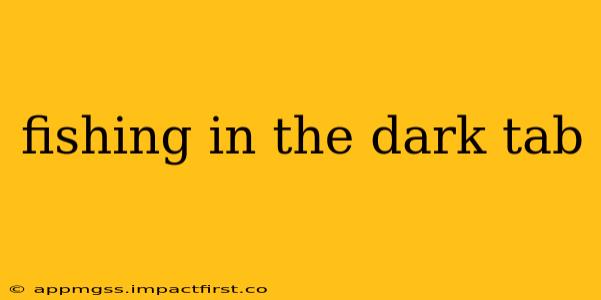Fishing in the dark presents a unique and exciting challenge for anglers. The stillness of the night, the mysterious movements of nocturnal creatures, and the thrill of the unexpected catch make it a truly rewarding, albeit demanding, experience. However, it requires specialized techniques, a strong understanding of safety precautions, and a different approach than daytime fishing. This comprehensive guide explores the art of fishing in the dark, addressing key concerns and offering practical advice.
What are the Advantages of Night Fishing?
Many anglers find night fishing offers distinct advantages. The reduced presence of other anglers translates to less competition for prime fishing spots and a more tranquil atmosphere. Furthermore, some species are more active at night, providing opportunities to target fish that are less accessible during daylight hours. The cooler night temperatures can also improve the handling of delicate catches, making it a particularly good time for fly fishing or targeting species sensitive to heat.
What are the Best Types of Lures for Night Fishing?
Choosing the right lure is crucial for successful night fishing. High-visibility lures are essential, as fish rely on different senses in low-light conditions. Consider these options:
- Glow-in-the-dark lures: These lures are readily available and offer a simple, effective way to attract fish.
- Lures with reflective surfaces: These lures will reflect even minimal light sources, creating flashes that attract attention.
- Brightly colored lures: While not glow-in-the-dark, lures with bold colors like chartreuse, white, or red can still stand out in the dark.
- Buzzbaits: These topwater lures create significant surface disturbances and noise, drawing in fish.
Experimentation is key; different species respond better to different types of lures.
What is the Best Time for Night Fishing?
The optimal time for night fishing varies depending on the target species and local conditions. Generally, the hours immediately after sunset and before sunrise are prime times, as fish are often most active during these periods of transition. The full moon can also significantly improve visibility, though it might make some species less active. Consult local fishing reports and forums to find the best times for the specific species and location you're targeting.
How Do I Stay Safe While Night Fishing?
Safety is paramount when fishing in the dark. Always prioritize the following:
- Wear bright clothing: This will improve your visibility to others, and especially to boat traffic if you are fishing from a boat.
- Use a headlamp or flashlight: Ensure it has a red light setting to preserve your night vision.
- Inform someone of your plans: Let a friend or family member know where you're going, when you expect to return, and what to do if you don't.
- Be aware of your surroundings: Pay attention to the terrain, any potential hazards (rocks, uneven ground, etc.), and boat traffic if applicable.
- Check weather conditions: Avoid fishing in inclement weather or during storms.
What are Some Recommended Night Fishing Techniques?
Adapting your fishing techniques for nighttime conditions is essential. These techniques can enhance your success:
- Slow and steady retrieve: Fish tend to be less aggressive at night, so a slower retrieve often proves more effective.
- Focus on structure: Fish often congregate around structure like docks, drop-offs, and weed beds at night, providing ideal fishing spots.
- Use a fish finder: A depth finder with sonar can help you locate fish and structure in the darkness.
- Be patient: Night fishing often requires patience and persistence.
Conclusion: Embracing the Darkness
Night fishing offers a unique and rewarding experience, but it demands preparation, skill, and a strong focus on safety. By understanding the best techniques, lures, and safety precautions, you can significantly increase your chances of a successful and enjoyable night out on the water. Remember to always prioritize safety, respect the environment, and practice responsible angling.
